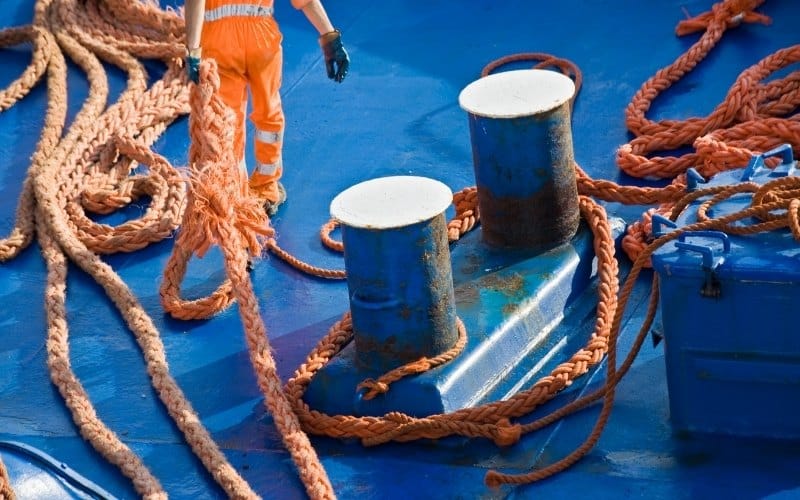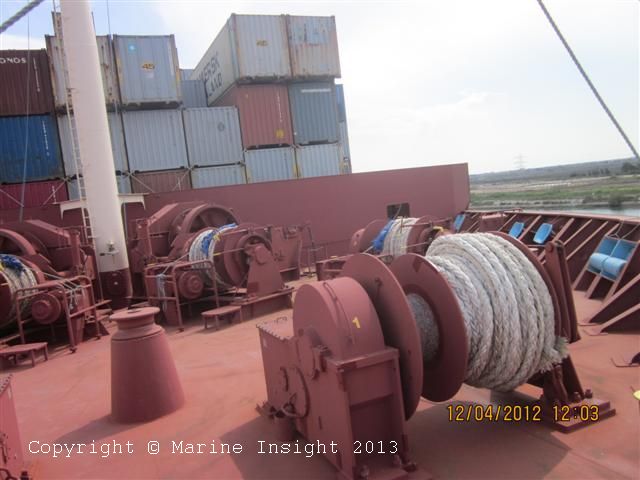

Mooring ropes found onboard are of varied types with good elasticity. Generally, mooring roles supplied onboard are of nylon, polyurethane and wire ropes.
A number of precautions along with good seamanship practise can increase the life of these ropes and prevent deterioration, chaffing, cutting and internal wear.
Some important points to be considered are as followed:
– Synthetic ropes should be kept away from direct sunlight.
– Ropes should preferably be stored under the deck for long voyages but if kept on deck they should be covered with tarpaulins or canvass to prevent exposure to sun and seawater or should be kept on gratings.
– While using a wire rope sharp angles should be avoided.
– A very common cause of a wire rope developing a kink is uneven turns, which are too tight or too slack where the wire gets snapped between the other turns on the drum. Thus, sharp angles or nips to be avoided with wire ropes.
– When heaving or slacking a wire, care should be taken so as to ensure that the turns on the drum are taken uniformly with sufficient tightness, avoiding any loose or extreme tight turns can cause the rope to get chaffed in between the turns and develop a kink. A good practice is to use rollers with wires to prevent unnecessary chaffing.


– Wire ropes should be regularly lubricated with recommended wire lubes, turret fluids or grease using wire rope lubricators, which helps grease reach the core of the wire and prevent corrosion. Greasing with hands may not be effective as it often lubricates the outer strands and the grease doesn’t reach the core of the wires.
– Whenever opening or uncoiling a new wire reel, follow the instructions provided for uncoiling the rope. In general, to prevent chaffing of a wire rope, rollers must be used. If wire rope is being runoff from one reel to a winch drum or another reel, run it from top to top or from bottom to bottom.
– If in any length of the 8 diameters of a wire rope the numbers of visible broken wires exceed 10% of the total number of wires in the rope, it should be discontinued from use. The more the number of wires in a strand, the more the wire is flexible. If flexibility increases the strength of the rope decreases.


– Mooring wires are provided with synthetic tail ropes at the end to secure. Tails being elastic thus provide the assembly for wire and tail to be tightened aptly while securing a vessel alongside. Tails are connected by means of tonsberg or mandal shackle. It is recommended to rig or connect the shackle in the correct manner as per the maker’s instructions to ensure proper transfer of forces and to provide flexibility.
– Avoid surging or chaffing of synthetic ropes to prevent wear and tear due to friction. Some ropes have a low melting point which can cause them to fuse permanently and get damaged. A rope should never be stowed in a wet condition to avoid rotting.
– While securing a synthetic rope on bitts the top turn should be secured against accidental springing off by means of light lashing. Synthetic ropes should be free of grease oil stains and paint marks as pose a greater danger while handling than various other shipboard activities.
– Long wires under tension can stretch enough to snap back with a considerable force. Possibility of snapback should always be considered while handling ropes as often the static energy stored in a synthetic rope gets released by parting off a rope and it snapping back to its own length. Synthetic lines do not essentially provide any external warning or signs against the danger of snapback. A hazard zone can be defined as a zone of ten-degree cone around the line from any point at which it may break.


– Excessive heat can damage synthetic fibre ropes. Coils of polypropylene and polyethylene should not be stored against steam lines, bulkheads with high temperatures or under direct sunlight. Some synthetic ropes can be damaged by chemicals such as acids, alkalies, paints or thinners. When a rope becomes oily it can be scrubbed with fresh water and any other effective cleaning material.
– Being not effectively resistant to cuts and abrasions, synthetic lines should not be exposed to deterrent conditions which can damage them. While dragging them contact with sharp edges should be avoided.
– The surface of chocks and fairleads are grooved or roughened by wires which may be grinded or levelled before use with synthetic lines. Dirt, grit, sand and rust particles often cling to and penetrate into synthetic ropes causing internal abrasion. Brushing or cleaning of ropes can be a good practice before stowing them.
– Kinks formed in ropes must be removed by easing up loads first. Coiling direction of rope too play an important role in the removal of kinks. Most lines are of right-handed lay and coiled clockwise. New rope from a coil can be removed by suspending with a shaft. Winch mounted lines can be turned end to end periodically to prevent uneven wearing.
Documentation which keep a track of wear and use of wire ropes, synthetic ropes and rope tails is helpful in planning maintenance schedule. Based on that few points to be considered are as under :
Over to you..
Do you know any other important points that can be added to the article?
Let’s know in the comments below.










We believe that knowledge is power, and we’re committed to empowering our readers with the information and resources they need to succeed in the merchant navy industry.
Whether you’re looking for advice on career planning, news and analysis, or just want to connect with other aspiring merchant navy applicants, The Marine Learners is the place to be.